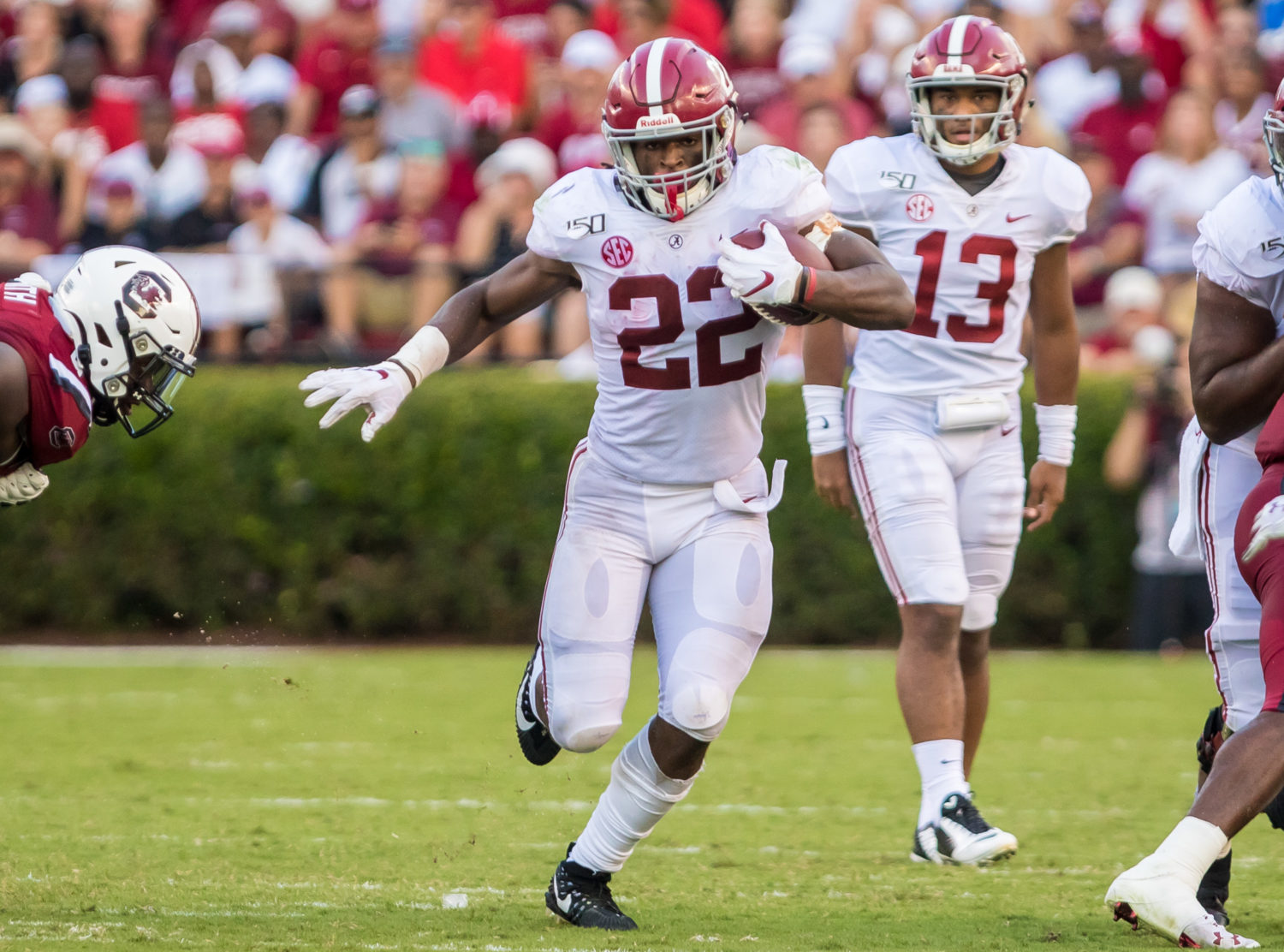
To run the ball, Alabama must find improvement on the offensive line
By David Wasson
Published:
Fully realizing that poking holes in a team that has won 5 national titles in the past 10 years, is ranked No. 2 in the country and has the Heisman Trophy front-runner in the backfield is a dicey proposition, we offer the following hypothesis:
Alabama’s offensive line is not very good right now.
Picking the nits? Sure. It isn’t like the Crimson Tide is *bad* up front. But through 3 games, it isn’t like the Crimson Tide is exactly *great* up front, either.
For those inclined to skip straight to the bottom to express their sincere desire that the author is insane, hear it out …
On paper, the starting 5 of left tackle Alex Leatherwood, left guard Evan Neal, center Chris Owens, right guard Landon Dickerson and right tackle Jedrick Wills, Jr. should be dominating games. Averaging just over 6-5 and 322.6 pounds of earth-moving humanity, the Tide’s starting offensive line stacks up size-wise with average NFL lines.
And the offensive line starters have been largely intact through 3 games. The only deviation was against New Mexico State, when Owens was replaced by Dickerson at center and redshirt senior Matt Womack (6-7, 325) took Dickerson’s spot at right guard.
One would think that a possible weak link in the offensive line would be Neal, a true freshman who was playing high school football last year at this time. But honestly, is it possible to call anyone 6-7, 360 a weak link? After all, Neal showed power, strong hands and quick feet that amazed coaches during the preseason in beating out Emil Ekiyor Jr., for the starting nod alongside Leatherwood on the left side of the line.
Dickerson has been a particular bright spot, too, as he was named SEC offensive lineman of the week for his play at right guard at South Carolina. Playing 58 snaps in Columbia, Dickerson didn’t allow a sack, quarterback hurry or pressure.
Nevertheless, the Tide starting offensive line has been spectacularly average in clearing the way for its running backs. Through 3 games, Alabama has gained a pedestrian 539 yards for a 179.7-yard average and has scored 7 TDs on the ground. (That includes the 75-yard screen pass to Henry Ruggs that counted as a run.) Through 3 games last season, Alabama rushed for 710 yards — 236.7 yards per game — and 7 rushing TDs.
“We really need to make improvement in the running game, period,” coach Nick Saban said before the South Carolina game. “And I think that’s everyone. I think our runners have to do a better job of running the tracks that we need to run to, I think when you run a play people don’t understand that by the runner running a track he actually makes the defense react a certain way when the runner’s on that track, so you actually get the defenders to come to the blocks.
“The offensive line is taking angles to block people assuming that’s going to happen. And we haven’t been consistent in that to this point and I think at times it’s affected our ability to be consistent in the running game. We need to get all that cleaned up and do that better.”
Alabama’s 76 rushing yards against the Gamecocks were the Tide’s 8th-fewest since Saban arrived at Alabama in 2007 and the fewest since 66 in a 14-13 victory over Arkansas in 2014. The amount of running plays called against South Carolina did not jibe with the balance Saban desires, as Alabama ran only 25 times, tied for the 3rd-fewest of the Saban era — more than only 23 in a win against The Citadel last season and 21 in a win against Colorado State in 2013.
“We need to have more balance on offense,” Saban said.
Unfortunately, it isn’t as simple as calling more running plays. Saban estimated after the game that at least half of Alabama’s play calls last week were run-pass options. And when South Carolina’s defense kept 6 defenders close to the line of scrimmage, Saban said the read for QB Tua Tagovailoa is to pass.
“You can’t really run with that, so you have to throw the ball,” Tagovailoa said after the game.
Alabama wasn’t totally toothless on the ground against South Carolina, though, as Najee Harris gained 19 yards on his 2 first-quarter carries. But that effort largely disappeared as the game wore on.
“When we did run the ball, we ran it fairly effectively,” Saban said. “We got a hat on a hat. We had a lot of positive runs. We just didn’t run it very much.”
And it isn’t like the Tide is exactly handcuffing itself when there isn’t an RPO called, as Alabama offensive coordinator Steve Sarkisian has a wealth of WR weapons for Tagovailoa to throw the ball to. So why run at all, right?
“I also think from a team standpoint, we need to be able to run the ball effectively as well,” Saban said. “I don’t think you can totally depend on (the passing game). I think last year we got to where we were so good (passing) we didn’t do other things well. And when we played other teams at the end, we couldn’t do enough other things to be effective.”
An APSE national award-winning writer and page designer, David Wasson has almost four decades of experience in the print journalism business in Florida and Alabama. His work has appeared in The New York Times, The Washington Post, the Los Angeles Times and several national magazines and websites. His Twitter handle: @TheSharpDW







